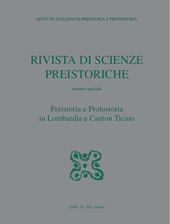Ipotesi di datazione sulla struttura circolare del Nuovo Ospedale Sant'Anna di Como in base ai dati archeobotanici
P. 671-683
Preceded by a geomorphological study, the archaeological and archaeobotanical investigation of the site of the Nuovo Ospedale Sant'Anna in Como was carried out in 2007. The radiometric dating of the botanical remains, found in three different levels of the circular structure of the hospital, has revealed the first human presence in the ancient Neolithic through the C14 analysis of A) the charcoals of the well US 885 dated 6113 ± 37 BP, B) a layer with ritual plowing (US 813E) located at a higher level than the well (dated to the Middle Bronze Age 3223 ± 24 BP) and C) a “radial filling” of the circular structure (US 577, datable to the Iron Age 2390 ± 37 BP). The discovery of 20 burials made it possible to better specify the last phases of use of the site: three within the circular structure referable to the early Iron Age, others from the same period and from the Roman Age outside the structure.
The analysis of over 200 charcoals coming from the well, from the plows, from the radial fillings and from the tombs of the 6th century BC, have helped to reconstruct the evolution of the forest cover along a chronological span of about 4000 years, also by means of the comparison with pollen data available in the literature. [Publisher's text]
Forma parte de
Rivista di scienze preistoriche : LXXII, supplemento, 2022-
Artículos del mismo número (disponibles individualmente)
-
Información
Código DOI: 10.32097/1202
ISSN: 2282-457X


